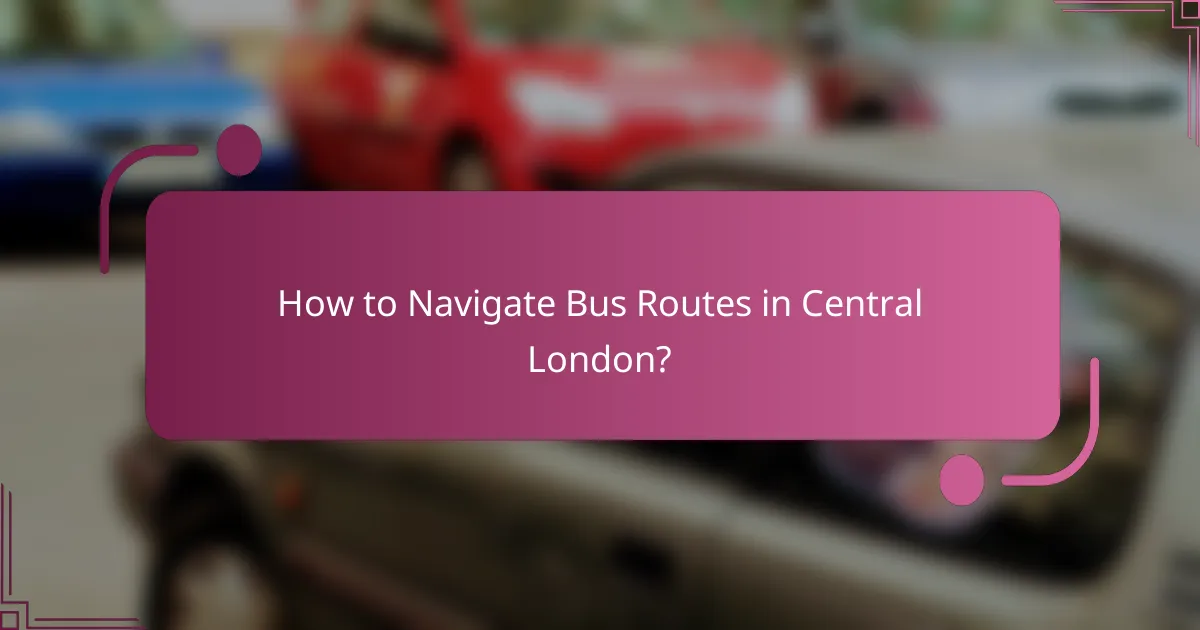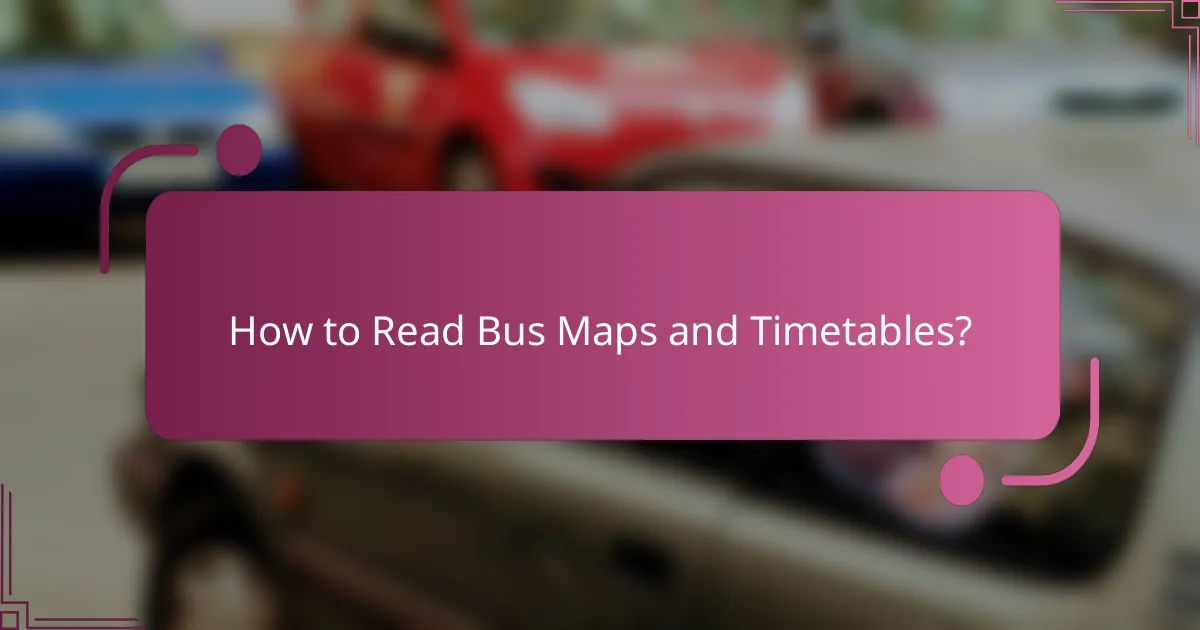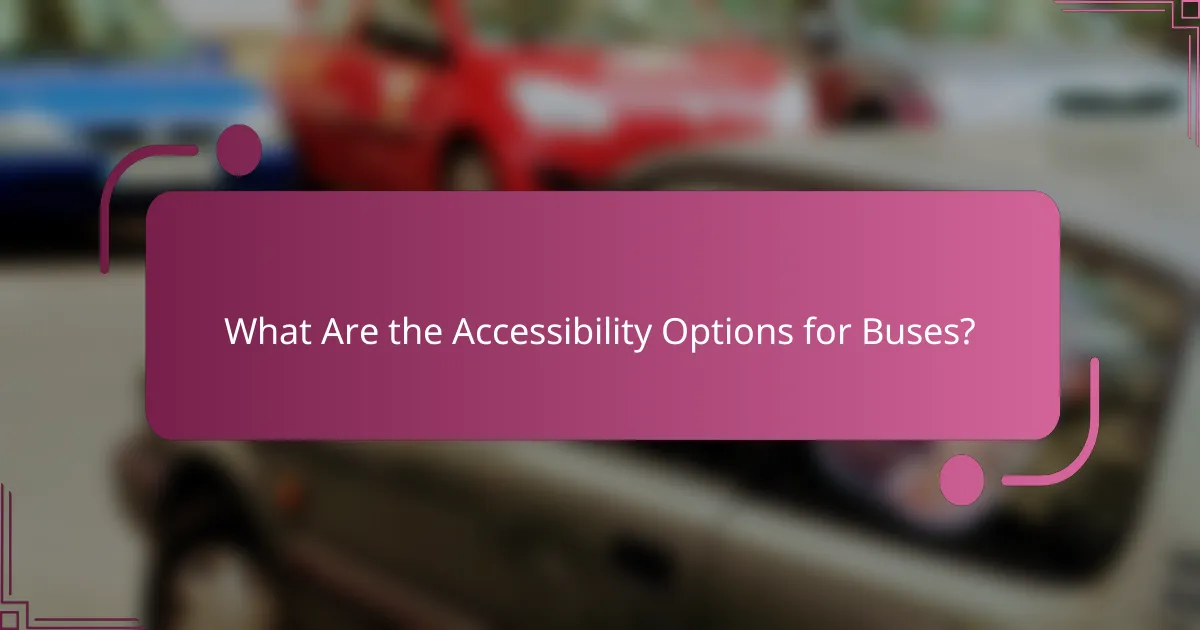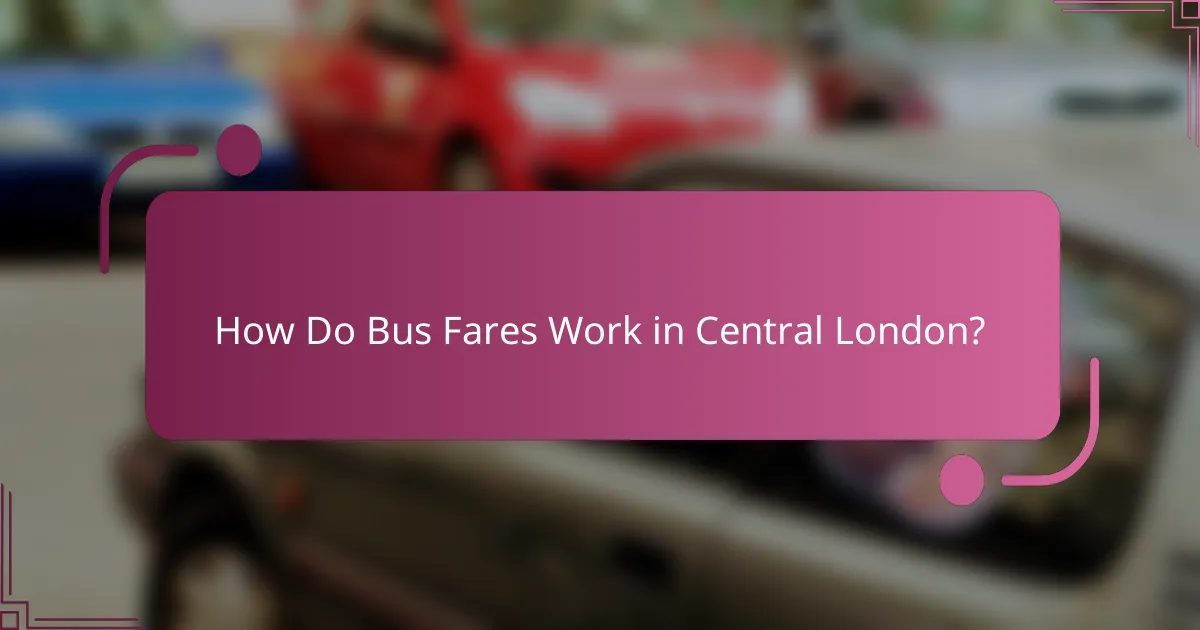Navigating bus routes in Central London can be straightforward with the right tools and strategies. By utilizing apps and online resources, commuters can enhance their experience, find optimal routes, and stay updated on schedules. Key bus routes connect major hubs, making efficient navigation of the city possible.

How to Navigate Bus Routes in Central London?
Navigating bus routes in Central London can be straightforward with the right tools and strategies. Utilizing apps and online resources can significantly enhance your commuting experience, ensuring you find the best routes and stay updated on bus schedules.
Use Transport for London (TfL) Journey Planner
The TfL Journey Planner is an essential tool for navigating bus routes in London. It allows you to enter your starting point and destination, providing you with the best bus options, estimated travel times, and any necessary transfers.
To maximize its effectiveness, consider checking the planner during peak hours when traffic can affect bus schedules. This tool is accessible via the TfL website and can be used on mobile devices for on-the-go planning.
Download the TfL Bus App
The TfL Bus App is a convenient resource for commuters, offering real-time bus information and route planning. With this app, you can track bus arrivals at your nearest stop, view service disruptions, and save your favorite routes for quick access.
Make sure to enable notifications for updates on delays or changes in service, which can help you avoid long waits and plan alternative routes if necessary.
Check Live Bus Arrivals
Checking live bus arrivals is crucial for efficient travel in Central London. You can find real-time arrival information at bus stops, on the TfL website, or through the TfL Bus App. This feature helps you know exactly when your bus will arrive, reducing uncertainty during your commute.
Keep in mind that live arrival times can fluctuate due to traffic conditions, so it’s wise to arrive at the bus stop a few minutes early to ensure you don’t miss your bus.
Utilize Google Maps for Bus Directions
Google Maps is a powerful tool for navigating bus routes in Central London. By entering your destination, you can select the public transport option to view bus routes, schedules, and estimated travel times.
When using Google Maps, pay attention to the suggested routes, as they often include walking directions to and from bus stops. This can help you plan your journey more effectively, especially in areas with multiple bus services.

What Are the Key Bus Routes in Central London?
Central London features several key bus routes that serve as vital arteries for commuters. These routes connect major hubs, making it easier to navigate the city efficiently.
Route 25: Oxford Circus to Ilford
Route 25 runs between Oxford Circus and Ilford, providing a direct link between central London and the eastern suburbs. This route is particularly useful for commuters traveling to and from the bustling shopping areas of Oxford Street and the residential areas of Ilford.
Key stops along Route 25 include Oxford Circus, Liverpool Street Station, and Ilford Station. Buses typically run every 8 to 12 minutes during peak hours, making it a reliable option for daily travel.
Route 38: Clapton to Victoria
Route 38 connects Clapton in the northeast to Victoria in central London, offering access to a variety of neighborhoods and attractions. This route is popular among commuters heading to work and those visiting landmarks near Victoria Station.
Notable stops include Clapton Pond, Hackney Central, and Victoria Station. Buses on this route generally operate every 10 to 15 minutes, providing a consistent service for passengers.
Route 73: Victoria to Stoke Newington
Route 73 operates between Victoria and Stoke Newington, serving both residential and commercial areas. This route is ideal for those commuting to work in central London or visiting local shops and cafes.
Key stops include Victoria Station, Oxford Street, and Stoke Newington Church Street. Buses usually run every 8 to 12 minutes, ensuring frequent service throughout the day.

How to Read Bus Maps and Timetables?
Reading bus maps and timetables is essential for efficient navigation in Central London. Understanding these tools allows commuters to plan routes effectively and minimize wait times.
Understanding the TfL Bus Map
The Transport for London (TfL) bus map displays all bus routes across the city, highlighting key stops and interchanges. Each route is color-coded, making it easier to identify which buses serve specific areas.
When using the map, pay attention to the route numbers and their corresponding colors. For example, the number 25 is shown in blue, indicating its path from Oxford Circus to Ilford. Familiarizing yourself with major landmarks along the routes can also help in navigation.
Interpreting Bus Timetables
Bus timetables provide crucial information about bus arrival and departure times at each stop. They typically list times for weekdays, weekends, and public holidays, which can vary significantly.
To effectively use a timetable, locate your bus route and check the times for your intended stop. Buses in Central London generally run every 5 to 15 minutes during peak hours, but this can extend to 20 to 30 minutes during off-peak times. Always check for any service changes or disruptions that may affect your journey.

What Are the Best Practices for Commuters?
To navigate bus routes in Central London effectively, commuters should adopt several best practices. These include planning journeys in advance, being mindful of peak travel hours, and staying updated on service alerts.
Plan Your Journey Ahead of Time
Planning your journey before you leave can save time and reduce stress. Use apps like Citymapper or the Transport for London (TfL) website to find the best routes and bus options available for your destination.
Consider factors such as bus frequency and potential delays. For example, some routes may have buses every 5-10 minutes during the day, while others may be less frequent, especially in the evenings or on weekends.
Be Aware of Peak Hours
Peak hours in Central London typically occur on weekdays from 7:30 AM to 9:30 AM and 4:30 PM to 6:30 PM. During these times, buses can be crowded, and delays are more likely.
To avoid the rush, try to travel outside these peak times when possible. If you must travel during peak hours, allow extra time for your journey to account for potential delays and overcrowding.
Keep an Eye on Service Alerts
Service alerts can impact bus routes and schedules, so it’s crucial to stay informed. Check the TfL website or follow their social media channels for real-time updates on disruptions or changes.
Additionally, many bus stops display live arrival information, which can help you make informed decisions about your travel plans. If a bus is delayed, consider alternative routes or modes of transport to reach your destination efficiently.

What Are the Accessibility Options for Buses?
Accessibility options for buses in Central London include features designed to assist passengers with mobility challenges. These options ensure that individuals can navigate the bus system with greater ease and independence.
Low-Floor Buses for Wheelchair Access
Low-floor buses are specifically designed to accommodate wheelchair users and those with limited mobility. These buses have a step-free entry, allowing for easy access from the curb to the bus interior.
Most low-floor buses are equipped with ramps that can be deployed by the driver, ensuring that passengers can board safely. It’s advisable to check the bus type in advance, as not all routes may have low-floor options available.
Audio and Visual Announcements
Audio and visual announcements on buses help passengers identify stops and routes, enhancing the travel experience for individuals with visual or hearing impairments. These systems provide real-time information, making it easier for all passengers to navigate their journey.
Passengers can expect clear audio announcements and digital displays that indicate the next stop and route information. Familiarizing yourself with these features can significantly improve your confidence when using the bus system.

How Do Bus Fares Work in Central London?
Bus fares in Central London are calculated based on a flat rate for single journeys, regardless of distance. As of now, the standard fare for adults using contactless payment or an Oyster card is around £1.65 per trip, with daily caps limiting total spending.
Contactless Payment Options
Contactless payment methods, such as debit and credit cards, are widely accepted on London buses. Simply tap your card on the card reader when boarding to pay your fare. This method allows for quick and easy transactions without the need for cash or physical tickets.
Using contactless payment can be advantageous as it automatically applies daily and weekly caps, ensuring you never pay more than a set amount for multiple journeys. Keep in mind that some cards may incur foreign transaction fees, so check with your bank before traveling.
Oyster Card Benefits
The Oyster card is a smart card that offers several benefits for bus travel in London. It provides discounted fares compared to cash payments and can be topped up easily at various locations, including stations and online. The current adult fare with an Oyster card is approximately £1.65 per journey.
Additionally, the Oyster card allows users to benefit from daily caps, which can save money for frequent travelers. It’s important to register your card online to protect your balance in case it gets lost or stolen, and consider using it for other transport options like the Tube and trains for even more savings.

What Are the Environmental Initiatives for Buses?
Environmental initiatives for buses in Central London focus on reducing emissions and improving air quality. These initiatives include the introduction of electric and hybrid buses, which significantly lower greenhouse gas emissions compared to traditional diesel buses.
Electric and Hybrid Buses in London
Electric and hybrid buses are key components of London’s strategy to enhance public transport sustainability. Electric buses operate solely on battery power, while hybrid buses combine a conventional engine with an electric motor, allowing for reduced fuel consumption and emissions.
As of recent years, London has introduced hundreds of electric buses into its fleet, with plans to expand this number significantly. These buses are equipped with advanced technology that allows for quieter operation and zero tailpipe emissions, making them ideal for urban environments.
When using electric or hybrid buses, commuters can expect a smoother ride and improved air quality in the city. However, it’s essential to check the bus schedules, as electric buses may have limited routes compared to their diesel counterparts. Always look for the latest updates on routes and availability to ensure a seamless commute.
